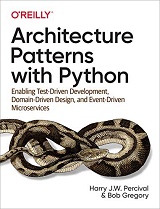Architecture Patterns with Python

简介:
支持测试驱动开发 (TDD) 、域驱动设计 (DDD) 和事件驱动微服务。随着Python越来越受欢迎,项目变得越来越大,越来越复杂。许多Python开发人员对高级软件设计模式感兴趣,例如六边形/干净架构,事件驱动架构以及域驱动设计 (DDD) 规定的战略模式。但是,将这些模式转换为Python并不总是那么简单。通过这个实践指南,Harry Percival和Bob Gregory fro m MADE.com介绍了经过验证的架构设计模式,以帮助Python开发人员管理应用程序的复杂性,并从他们的测试套件中获得最大的价值。每个模式都使用漂亮的惯用Python中的具体示例进行说明,避免了Java和C # 语法的一些冗长。模式包括:
依赖性反转及其到端口和适配器的链接 (六边形/干净的体系结构)领域驱动设计在实体、值对象和聚合之间的区别持久存储的存储库和工作单元模式事件、命令和消息总线命令-查询责任分离 (CQRS)事件驱动架构和反应式微服务
英文简介:
Enabling Test-Driven Development (TDD), Domain Driven Design (DDD), and Event-Driven Microservices.
As Python continues to grow in popularity, projects are becoming larger and more complex. Many Python developers are taking an interest in high-level software design patterns such as hexagonal/clean architecture, event-driven architecture, and the strategic patterns prescribed by domain-driven design (DDD). But translating those patterns into Python isn't always straightforward.
With this hands-on guide, Harry Percival and Bob Gregory from MADE.com introduce proven architectural design patterns to help Python developers manage application complexity—and get the most value out of their test suites.
Each pattern is illustrated with concrete examples in beautiful, idiomatic Python, avoiding some of the verbosity of Java and C# syntax. Patterns include:
Dependency inversion and its links to ports and adapters (hexagonal/clean architecture)Domain-driven design’s distinction between Entities, Value Objects, and AggregatesRepository and Unit of Work patterns for persistent storageEvents, commands, and the message busCommand-query responsibility segregation (CQRS)Event-driven architecture and reactive microservices
- 书名
- Architecture Patterns with Python
- 译名
- 使用 Python 的架构模式
- 语言
- 英语
- 年份
- 2020
- 页数
- 497页
- 大小
- 9.60 MB
- 标签
- Python
- 下载
 Architecture Patterns with Python.pdf
Architecture Patterns with Python.pdf- 密码
- 65536
最后更新:2025-04-12 23:54:38
←Patterns for Beginning Programmers with Examples in Java
→Clean Architectures in Python: A Practical Approach to Better Software Design